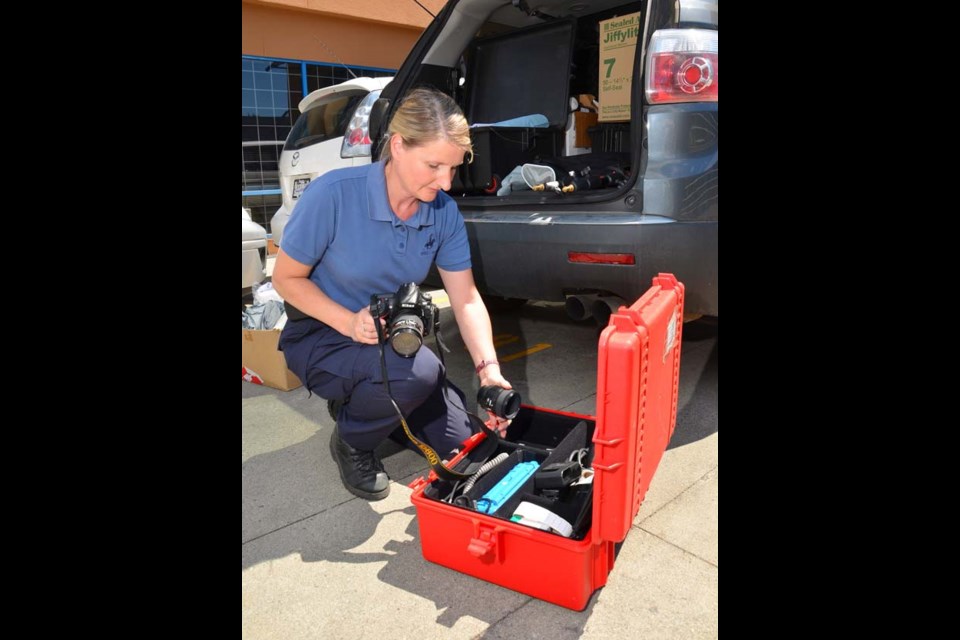Her field is called forensic taphonomy, the study and interpretation of the changes that occur to human remains from the point of death to discovery at crime scenes, and Sgt. Diane Cockle is the world's first to earn a PhD examining the progression of human decomposition in Canada.
Cockle started as an archaeologist and now works with the RCMP's National Forensic Identification Support Services. She recently graduated rom SFU, with a PhD n forensic anthropol-gy from the department of archaeology. Her thesis project was on forensic taphonomy.
Question: So, tell me a bit about what you do?
Answer: I work as a special crime scene investigator for the National Forensic Identification Support Services section in Vancouver B.C. For the most part, I help police agencies in B.C. and the Yukon with homicide scenes where there's a need to analyze and interpret the blood stains at a homicide scene, or with the recovery of human remains from an outdoor scene. As a bloodstain pattern analyst, I examine the two-dimensional bloodstains created by the trauma inflicted on a victim by a suspect, in order to reconstruct what happened.
Q: What kind of things can you figure out by analyzing a body?
A: A body will look different depending on whether it decomposed, inside, outside, in water or in a burial.
Now that this research has been completed, we can say for the first time whether or not a body has been moved from one scene to another. This information will help crime scene investigators determine, for example, whether a body discovered on the bank of the river was washed in from the river or placed there from the land, hoping the river would take it.
VIDEO: Sgt. Diane Cockle walks us through her forensic tool kit, Part 1
Q: Can you explain why this work is so important, especially with respect to wrongful convictions?
A: One of the main purposes of forensic taphonomy is to determine what changes to the body were caused by nature - natural decomposition, scavenging, insect activity - and what changes were caused by the suspect around the time of death. There is a risk of wrongful convictions when trauma caused by scavengers - teeth marks or tears - are misinterpreted as cut marks and stabs.
Q: What drew you to this?
A: As a professional archaeologist, I always enjoyed the challenge of putting together what happened in the distant past with the artifacts that were discovered at a site. What drew me to the RCMP was the fact that I could use those same skills to reconstruct what happened at a crime scene and contribute to today's society in a relevant and positive way.
Q: I suspect most people would be repulsed by decomposing bodies. How do you handle that?
A: People are often repulsed by what they don't understand. A decomposed body is not some-thing that most people have to deal with, so they are shocked by the visible state and smell of the body because it's unfamiliar to them. I understand the biological processes which decompose us, and I'm used to the sight and smell of it; not that it makes it any more pleasant, it just makes it less shocking.
Q: How would you describe your relationship or attitude towards death, given that you work so closely with the subject?
A: In a bizarre way, it's a healthy relationship. I know only too well what unexpected and tragic ways death can come to us. I use that as a motivator to ensure that I never postpone, and I don't pass up an opportunity or experience.
Q: I understand you are called to most murder scenes and found bodies in B.C., and you've also worked on some high profile cases, like the missing women investigation at the Pickton farm. What was that like?
VIDEO: Sgt. Diane Cockle walks us through her forensic tool kit, Part 2
A: The fact that all the scenes I attend are homicides certainly adds pressure. I have to make sure that I'm always on my game, I can never have an off day, and any mistakes that I make have serious consequences. I try very hard not to make any mistakes!
Q: How did your work influence your PhD pursuits?
A: I think my experience as a crime scene examiner helped me during my PhD. For both, you need to be meticulous, detail-oriented and completely obsessive compulsive.
Q: And you've also been to Rwanda to work as a forensic investigator on war crimes cases? What was that like?
A: Going to Rwanda was fascinating. I feel like I have a real connection to that country, the conflict, and all the Rwandans who have survived it and are trying to move past it. Whenever you travel to places like Rwanda, I come home to B.C. and Canada with a greater appreciation of the life I live and the country I live in.
Q: How do you stay sane?
A: I have a very understanding husband - very understanding. I try to split myself into two people: the normal off-duty me that hides her eyes at the squeamish parts in movies and faints at the sight of her own blood, and the crime scene investigator who cannot be grossed out and can handle any manner of gruesome scene. The key is to keep those two people from ever meeting each other at the scene or at home.
Q: What's next for you?
A: I plan on taking the results of my research to the crime scene examiners to give them another tool in their scene toolbox. I am continuing my research on human decomposition. I'll be going up to the Yukon this summer to start a project looking at the differences between decomposition in the south versus the north in Canada. The focus for this summer however, is to reclaim some free time to reintegrate myself back into normal society after this seven-and-a-half year mental marathon (to finish the PhD).



